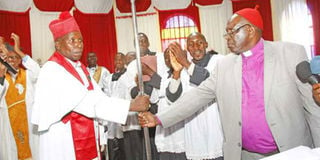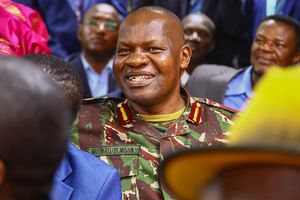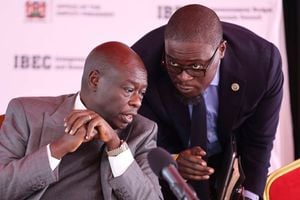Fresh bid to end AIPCA church leadership wrangles

Then outgoing African Independent Pentecostal Churches of Africa (AIPCA)Archbishop Amos Kabuthu (right) symbolically hands over the reins to archbishop-elect Fredrick Wang’ombe at AIPCA Njoro in Nakuru on February 19, 2017. The move led to leadership wrangles in the church that persist to date. PHOTO | FILE | NATION MEDIA GROUP
What you need to know:
- The opposing factions were three but reduced to two after a splinter church – AIPCK – that was led by Archbishop Samson Muthuri folded to merge with Mr Wang’ombe’s group.
- AIPCK was founded by the late John Mugecha who broke away from the AIPCA following a prolonged dispute with the first AIPCA archbishop Benjamin Kahihia.
Leadership wrangles that have for a long time become synonymous with the AIPCA church are poised to end should a group that is spearheading reconciliation of two factions succeed in its mission.
The group, whose membership is solely drawn from the church, is working on uniting the two church Archbishops – Julius Njoroge and Fredrick Wang’ombe – and their followers.
FACTIONS
Earlier, the opposing factions were three but reduced to two after a splinter church – AIPCK – that was led by Archbishop Samson Muthuri folded to merge with Mr Wang’ombe’s group. The move left Mr Njoroge as an isolated man with minority members.
AIPCK was founded by the late John Mugecha who broke away from the AIPCA following a prolonged dispute with the first AIPCA archbishop Benjamin Kahihia.
The reunion of Mr Muthuri and Mr Wang’ombe was brokered by a State House events’ business magnate from Tetu in Nyeri County.
The two held their first service together, which was attended by about 3,000 people, at Muthua-ini AIPCA in Nyeri in April last year.
DISPUTE
But the dispute got worse and the faithful, mostly in Nyandarua, Kiambu, Nairobi, Murang’a, Nyeri, Laikipia, Nakuru and Kirinyaga counties took sides, leading to criminal prosecution of some worshippers and the clergy over assault-related incidents.
For instance, in May 2019, Archbishop Njoroge met huge resistance at Kiuu AIPCA Church in Githurai after worshippers stormed out of the church when he showed up for a service.

AIPCA archbishop elect Julius Njoroge sprinkles during a church service at Ngangarithi, Nyeri, on February 26, 2017. PHOTO | FILE | NATION MEDIA GROUP
After the widespread feuds intensified, a group of worshippers converged and launched a unity movement with the aim of containing the ensuing hostilities and marking a new beginning for the church.
The plan was also to ensure the disputes would not worsen further and reconcile the two bitter rival factions.
Different bishops of various dioceses, supporting the unity agenda but separately loyal to either Wang’ombe or Njoroge, are also doing Sunday sermon exchange programmes.
EXCHANGE PROGRAMME
“In the exchange programme, you may find a bishop aligned to Wangomb’e preaching in a diocese headed by a bishop aligned to Njoroge and the vice versa. This is to bring peace and harmony among worshippers,” said a Murang’a bishop and a member of the unity group.
There is also confusion on who between Mr Njoroge and Mr Wang’ombe will be recorded as the fifth spiritual head after Amos Kabuthu, Ndung’u Kibe, Mwangi Gaitho and Benjamin Kahihia.
The unity group has been moving around various churches mostly within Nairobi and central Kenya regions sensitising the worshippers that they should not be fighting because of the differences between their spiritual leaders.
“Last year we met the two archbishops separately and informed them about our mission of uniting the church followers and they blessed and allowed us to continue,” said Ms Judy Dorah Njeri, one of the leaders in the group.
She added: “We only preach peace, love and unity amongst the worshippers regardless of one’s loyalty.” Their efforts started after the President Uhuru Kenyatta-sponsored 2018 mediation talks collapsed due to what was reported as hardline positions by the two (Wangombe and Njoroge) claimants of the church’s throne and their immediate associates.
MEDIATION PROCESS
President Kenyatta’s failed mediation process was said to have cost at least Sh12 million. The President had appointed retired bishops Lawi Imathiu and Peter Njenga of Methodist Church to lead the talks.
In the flopped conflict resolution process, Mr Njoroge, Mr Wang’ombe and Mr Muthuri had agreed to have the church divided into three main archdioceses headed by each of them. They would also have one of them as the national archbishop.
But the proposal, which had been handed to State House comptroller together with the two retired bishops, was scuttled by the church elders on grounds that the three archbishops lacked capacity to appoint the national spiritual head.
The leadership wrangles started in 2017 after retired Archbishop Amos Kabuthu declined to hand the leadership mantle to Mr Njoroge, who had been elected by the bishops.
SUCESSION
Instead, Mr Kabuthu used the alternative succession plan in the church constitution and gave Mr Wang’ombe the leadership shepherd stick. It also emerged that some members of the board that conducted Mr Njoroge’s election had retired, a move that caused more confusion.
After the failed mediation, Mr Njoroge has remained opposed to a negotiation deal on leadership and demanded adherence to the church constitution and the Societies Act in tracing what went wrong in the Kabuthu succession.
The differences between the two archbishops are so hot that Mr Njoroge uses Thika Diocese Cathedral as his main office while Mr Wang’ombe operates from the church’s traditional headquarters in Bahati, Nairobi.
“Despite Njoroge operating in Thika, his postal address reads Bahati. Njoroge has the minority churches because Wang’ombe and Muthuri combined their forces and have more than 250 churches now. Wang’ombe also enjoys State backing though his status as Archbishop has remained questionable,” said another member of the group in confidence.
The member also disclosed that the group, though it has membership from the three sides, is facing hostility in some churches as it is perceived to be pro-Wang’ombe.
RESISTANCE
For instance, it met resistance at AIPCA Athena in Thika, which is Mr Njoroge’s stronghold, and were blocked from worshipping there.
“We did not force ourselves because we do not want drama. Ours is to let the worshippers be aware that problems bedevilling the church are at the top, not amongst them,” stated the follower.
They later went to Wangigi in Kiambu and were well received, and in return they donated metallic windows and doors for construction of a church that had stalled.
The group has also planned a meeting with a retired bishop, Mr Ichungu, at his home in Karure Gatundu North on February 29, 2020 to borrow guidance on unity of the church. The retired bishop will also be celebrating 109 years since his birthday.





